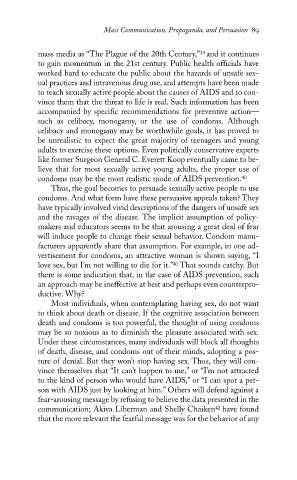Page 107 - The Social Animal
P. 107
Mass Communication, Propaganda, and Persuasion 89
39
mass media as “The Plague of the 20th Century,” and it continues
to gain momentum in the 21st century. Public health officials have
worked hard to educate the public about the hazards of unsafe sex-
ual practices and intravenous drug use, and attempts have been made
to teach sexually active people about the causes of AIDS and to con-
vince them that the threat to life is real. Such information has been
accompanied by specific recommendations for preventive action—
such as celibacy, monogamy, or the use of condoms. Although
celibacy and monogamy may be worthwhile goals, it has proved to
be unrealistic to expect the great majority of teenagers and young
adults to exercise these options. Even politically conservative experts
like former Surgeon General C. Everett Koop eventually came to be-
lieve that for most sexually active young adults, the proper use of
condoms may be the most realistic mode of AIDS prevention. 40
Thus, the goal becomes to persuade sexually active people to use
condoms. And what form have these persuasive appeals taken? They
have typically involved vivid descriptions of the dangers of unsafe sex
and the ravages of the disease. The implicit assumption of policy-
makers and educators seems to be that arousing a great deal of fear
will induce people to change their sexual behavior. Condom manu-
facturers apparently share that assumption. For example, in one ad-
vertisement for condoms, an attractive woman is shown saying, “I
41
love sex, but I’m not willing to die for it.” That sounds catchy. But
there is some indication that, in the case of AIDS prevention, such
an approach may be ineffective at best and perhaps even counterpro-
ductive. Why?
Most individuals, when contemplating having sex, do not want
to think about death or disease. If the cognitive association between
death and condoms is too powerful, the thought of using condoms
may be so noxious as to diminish the pleasure associated with sex.
Under these circumstances, many individuals will block all thoughts
of death, disease, and condoms out of their minds, adopting a pos-
ture of denial. But they won’t stop having sex. Thus, they will con-
vince themselves that “It can’t happen to me,” or “I’m not attracted
to the kind of person who would have AIDS,” or “I can spot a per-
son with AIDS just by looking at him.” Others will defend against a
fear-arousing message by refusing to believe the data presented in the
42
communication; Akiva Liberman and Shelly Chaiken have found
that the more relevant the fearful message was for the behavior of any

